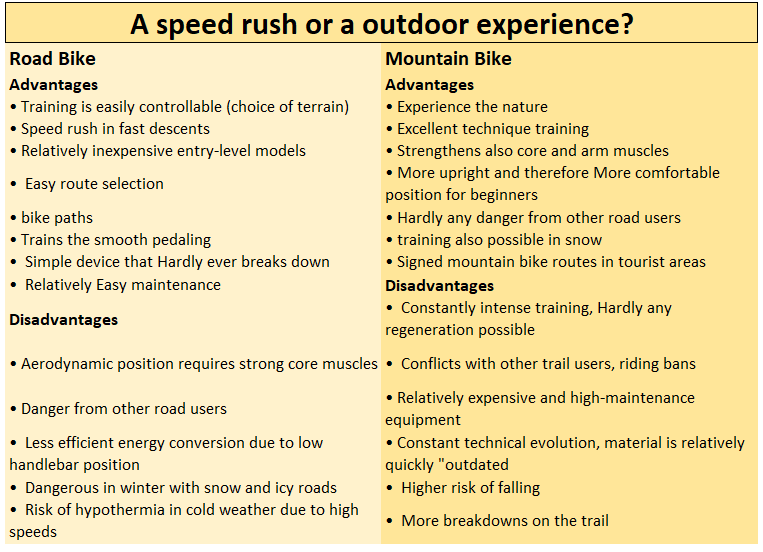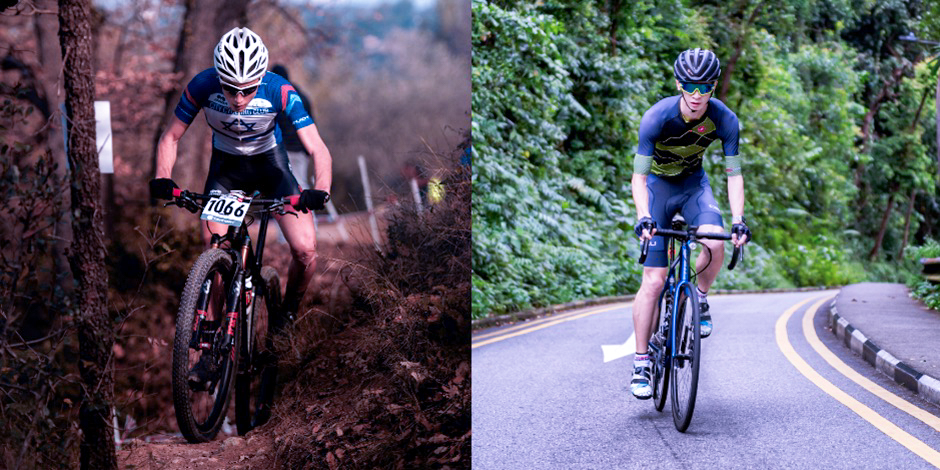Mountain bikers could become faster if they supplemented their training with road biking. At the same time, road cyclists often underestimate the benefits of using mountain bikes to improve their technical skills. Let’s explore in detail the differences and similarities between these two disciplines.
The transition from Mountain bike to Road bike
From time to time, a top cyclist announces that he wants to switch disciplines. A successful example of this transition is Matthieu van der Poel, who successfully made the switch from mountain biking to professional road cycling in the World Tour. However, it is rare to find road cyclists who switch to mountain biking.
On the other hand, it is becoming more common to see young mountain bikers who are not afraid of road bikes and ride regularly on the road during the spring. This provides valuable training for the MTB season, which starts about two months after the road season.
 The terrain difference
The terrain difference
Road bike and Mountain bike. Two worlds or one? In the following, similarities and differences will be analysed. The first thing to emphasize is that cyclists can learn valuable lessons from both styles. One of the most obvious distinctions between the two is the greater power required by mountain biking. The term itself, ‘Mountain’, says it all: if you’re going up a mountain, you need power. If the ground is rough, you need even more power. The terrain makes the difference to a racing bike.
Most mountain bike athletes do their preparation phase, which usually starts in December, on the road. However, snow riding with a MTB is an ideal training for riding technique. The actual technical training on the mountain bike does not start for the members of the national teams until March. During the first training camp, the racing bike stays at home and instead the mountain bike is ridden over hill and dale.
Different position
You sit differently on a mountain bike than on a road bike, more upright, without the bike being shorter. The top tubes of mountain bike frames are often even longer than those of road bikes for the same body size. However, shorter stems more or less compensate for these differences. Despite these different geometries, the muscles activate broadly similar areas of the body. Because of the more upright position and higher handlebar, the rider’s weight is distributed more evenly between the front and rear wheels, which helps maintain stability on uneven terrain.
The slightly more upright riding position on a mountain bike mainly affects the hip flexor. This ensures that the knee is raised and is thus used in the upward movement during the pedal rotation. The distance between the muscle attachments of the hip flexor increases when you sit upright. This allows it to use a greater range of motion and work somewhat more efficiently. However, since the hip flexor is only active in the pull phase, which is only a small part of the force development, the difference between the mountain bike and road bike position remains negligible.
To find out which position is more efficient – the racing bike or the mountain bike – we conducted a study together with Andreas Gösele, a sports physician at the Basel Cross Clinic. Gösele, himself an enthusiastic cyclist, developed a bicycle ergometer in collaboration with the Basel bicycle manufacturer Oskar Lehner. With this device, we were able to reproduce the sitting positions of racing cyclists and mountain bikers with millimetre precision. Sandro Späth swung himself into the saddle as the test person. Gösele transferred Späth’s positions on the road bike and mountain bike, which he had optimised over the years, to his device.
Sandro Späth rode in both the mountain bike and road bike positions with a power output of 100 watts, measured with an SRM crank. In the more upright but not shorter mountain bike position, the professional biker pedalled with a heart rate just below 100 beats per minute. Leaning on the racing handlebars, the rate increased slightly. When he positioned himself at the bottom of the arc for optimal aerodynamics, his heart had to beat about 5% faster than in the mountain bike position.
Andreas Gösele confirms: “The lower you sit bent forward, the worse it is for performance.” The medical explanation for this is that the large veins and arteries run across the thighs. Where they enter the torso, they can become kinked, which affects blood circulation. The more a cyclist sits leaning forward, the more blood flow is impeded. This can go so far that a road cyclist gets numb feet due to a too low handlebar position, as the foot is no longer supplied with sufficient blood.
However, the conclusion that higher handlebars make you faster is wrong. Gösele explains: “The lower I sit, the more aerodynamic I am. The aerodynamic advantages outweigh them so much that you ride faster despite a slightly reduced efficiency. The losses in power become a minor matter.”
Create an artificial intelligence-based training plan for triathlon, cycling and running with 2PEAK that adapts to your performance after each workout. Click here to download the app.
Positive instead of Negative
In mountain biking, aerodynamics play a secondary role. “In technically demanding races, we average less than 20 kilometres per hour,” says Späth. Being more upright is not a disadvantage. On the contrary: you ride more safely, have a better overview and: ‘With a higher handlebar I have fewer back problems,’ says Späth. The lower you have to bend down on the handlebars, the greater the holding work and therefore the more force required from your upper body. A force that would be better preserved for the legs. Back pain is usually a sign that the upper body muscles are slowly weakening.
This is also the reason why mountain bikers are abandoning the extremely low handlebars that were fashionable only a few years ago. Negative handlebar stems, i.e. those angled downwards, have now almost disappeared in the professional sector. However, the handlebar level is still lower than the saddle level. It has to be that way. Otherwise, the bikes would climb with difficulty, the centre of gravity would be too far back and the front wheel would lift off the ground more quickly.
For healthy athletes, however, this rule can be broken. In fact, the less the spine has to bend, the less the intervertebral discs are compressed. The latter can absorb shocks better when they reach the saddle. The strain on the hands is also reduced. A pressure-sensitive nerve channel runs between the thumb and little finger. Excessive pressure on this channel makes the fingers numb. In reality, this problem should mainly occur in road cycling, where the weight of the hands is greater. But practice is different. Less violent blows and the possibility of changing grip position on the road bike alleviate the problem. If your hands still get numb, consider buying gloves with good padding or installing a soft handlebar tape, e.g. made of cork. Professionals often wrap two layers around the handlebars to pedal more comfortably. Mountain bikers have the advantage of screwing the grips onto the handlebars, so they can change position regularly and reduce pressure on the delicate inner hand area.
Encourage variety
Switching from one discipline to another is not only harmless, but actually beneficial. The road cyclist can strengthen the muscles of the upper body on the mountain bike. On the ground you work with your whole body, your arms have to cushion, pull, push, you often stand for technical passages on the pedals. So you need tension in the body, which can only be created with strong core muscles. The second advantage is the riding technique. With the bike, you playfully learn to jump over obstacles, react in fractions of a second, and steer correctly in critical situations, e.g. with slipping wheels.
In contrast, the mountain biker on the road bike can train smooth pedalling, hone high-speed cornering technique, train speed endurance and fundamentals. “I know of no negative influence of one discipline on the other,” encourages Gösele. Finally, the mental component also comes into play. The fact that road pro Alexandre Moos was quickly dropped at the Swiss Bike Masters after a strong start and then retired did not matter much to him. Because with his excursions into the mountain bike world he wants to achieve one thing above all: to get away from the road life and enjoy cycling. For him, who has already stood on the podium several times in the national bike race series, mountain biking means a break from the season.
Are you ready to revolutionize your training? Try 2PEAK free for 14 days!
This blog article was made available to us by Fit for Life. Fit for Life is the Swiss fitness, running and endurance sports magazine. Would you like to read these articles regularly? Then click here.



